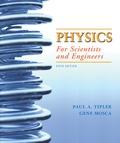
Concept explainers
(a)
To show:
The coefficient of the reflection and transmission is zero and
(a)
Explanation of Solution
Given:
Formula used:
Consider:
Mass per unit length for the first string is given as:
Mass per unit length for the second string is given as:
The coefficient of the reflection is given as:
The coefficient of the transmission is given as:
Calculation:
The speed of the pulse on the first string is calculated as:
The speed of the pulse on the second string is calculated as:
Divide the equation (1) by equation (2) as:
Now, the coefficient of the reflection is calculated as:
Now put the values of
Hence, the coefficient of reflection at
The coefficient of the transmission is given as:
Divide the numerator and denominator of the above equation by
Now the put the value of the ratio of
Now put the values of
The coefficient of the transmission at
(b)
To show:
The coefficient of the reflection and transmission is
(b)
Explanation of Solution
Given:
Formula used:
Consider:
Mass per unit length for the first string is given as:
Mass per unit length for the second string is given as:
The coefficient of the reflection is given as:
The coefficient of the transmission is given as:
Calculation:
The speed of the pulse on the first string is calculated as:
The speed of the pulse on the second string is calculated as:
Divide the equation (1) by equation (2) as:
But as per the given condition: if
Now, the coefficient of the reflection is calculated as:
The coefficient of the transmission is given as:
Divide the numerator and denominator of the above equation by
The coefficient of the reflection and transmission at
(c)
To show:
The coefficient of the reflection and transmission is
(c)
Explanation of Solution
Given:
Formula used:
Consider:
Mass per unit length for the first string is given as:
Mass per unit length for the second string is given as:
The coefficient of the reflection is given as:
The coefficient of the transmission is given as:
Calculation:
The speed of the pulse on the first string is calculated as:
The speed of the pulse on the second string is calculated as:
Divide the eq. (1) by eq. (2) as:
But as per the given condition: if
Now, the coefficient of the reflection is calculated as:
The coefficient of the transmission is given as:
Divide the numerator and denominator of the above equation by
The coefficient of the reflection and transmission at
Want to see more full solutions like this?
Chapter 15 Solutions
Physics for Scientists and Engineers
- Pls help ASAParrow_forward12. A motorboat traveling 6 m/s, West encounters a water current travelling 3.5 m/s, South. a) Draw a vector diagram showing the resultant velocity, then determine the resultant velocity of the motorboat. b) If the width of the river is 112 m wide, then how much time does it take for the boat to travel shore to shore? c) What distance downstream does the boat reach the opposite shore?arrow_forwardLake Erie contains roughly 4.00⋅10114.00⋅1011 m3 of water. Assume the density of this water is 1000. kg/m3 and the specific heat of water is 4186 J/kg˚C. It takes 2.31x10^19 J of energy to raise the temperature of that volume of water from 12.0 °C to 25.8 ˚C. An electric power plant can produce about 1110 MW. How many years would it take to supply this amount of energy by using the 1110 MW from an electric power plant?arrow_forward
- Pls help ASAParrow_forwardPls help ASAParrow_forwardm m $2° 15. A truck is stopped at a red light. Once the light turns green, the truck accelerates forward at 1.75- that same instant, a car moving with a constant speed of 50 — passes the truck. a) How many seconds will it take for the truck to catch up to the car? S b) How many metres will the truck travel before it catches up to the car? Atarrow_forward
- Pls help ASAParrow_forwardI need help adding more information to my study guide. This is subject is physics My topic : Emission Spectrum Target Material I need information on this topic but make it as study guide form and make 5 questions and include the answers.arrow_forwardAn electron and a proton are each moving at 755 km/s in perpendicular paths as shown in (Figure 1). Find the magnitude of the total magnetic force that the electron exerts on the proton. Find the magnitude of the total electrical force that the electron exerts on the proton.arrow_forward
 Classical Dynamics of Particles and SystemsPhysicsISBN:9780534408961Author:Stephen T. Thornton, Jerry B. MarionPublisher:Cengage Learning
Classical Dynamics of Particles and SystemsPhysicsISBN:9780534408961Author:Stephen T. Thornton, Jerry B. MarionPublisher:Cengage Learning Physics for Scientists and Engineers: Foundations...PhysicsISBN:9781133939146Author:Katz, Debora M.Publisher:Cengage Learning
Physics for Scientists and Engineers: Foundations...PhysicsISBN:9781133939146Author:Katz, Debora M.Publisher:Cengage Learning
 University Physics Volume 1PhysicsISBN:9781938168277Author:William Moebs, Samuel J. Ling, Jeff SannyPublisher:OpenStax - Rice University
University Physics Volume 1PhysicsISBN:9781938168277Author:William Moebs, Samuel J. Ling, Jeff SannyPublisher:OpenStax - Rice University Principles of Physics: A Calculus-Based TextPhysicsISBN:9781133104261Author:Raymond A. Serway, John W. JewettPublisher:Cengage Learning
Principles of Physics: A Calculus-Based TextPhysicsISBN:9781133104261Author:Raymond A. Serway, John W. JewettPublisher:Cengage Learning Physics for Scientists and EngineersPhysicsISBN:9781337553278Author:Raymond A. Serway, John W. JewettPublisher:Cengage Learning
Physics for Scientists and EngineersPhysicsISBN:9781337553278Author:Raymond A. Serway, John W. JewettPublisher:Cengage Learning





